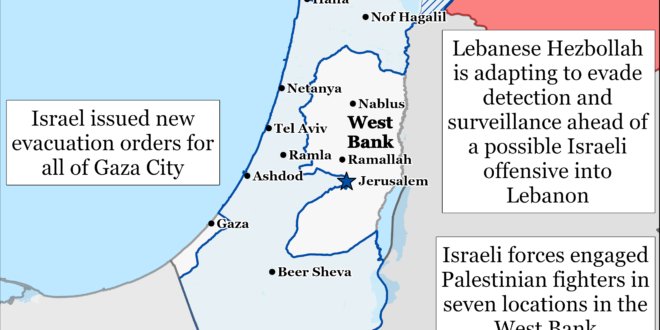Palestinian militias, including Hamas, are continuing to coordinate militarily and politically with Iranian-backed Iraqi militias. Popular Front for the Liberation of Palestine (PFLP) Deputy Secretary General Jamil Mazhar met with the leaders of Iranian-backed Iraqi militias Asaib Ahl al Haq, the Badr Organization, and the Jihad and Construction Movement in Baghdad on July 8 and 9.[i] The Jihad and Construction Movement is affiliated with the Badr Organization and controls the Popular Mobilization Forces 17th Brigade.[ii] Mazhar called for increasing coordination between Palestinian and Iranian-backed Iraqi militias during his meetings with the militia leaders. Mazhar praised the Islamic Resistance in Iraq—a coalition of Iranian-backed Iraqi militias—for “exhausting” the United States and Israel through its repeated attacks targeting US bases and Israeli targets since October 2023.[iii] Mazhar separately discussed Palestinian militia activities in the West Bank. Unspecified Hamas and Palestinian Islamic Jihad (PIJ) officials attended Mazhar’s meeting with Hadi al Ameri, who is head of the Badr Organization.[iv]
The PFLP, Hamas, and PIJ delegations’ visit to Baghdad comes amid reports that Hamas plans to relocate its political leadership to Iraq. Emirati media reported in late June 2024 that Hamas plans to move its political leadership to Iraq due to growing pressure from the United States and Qatar on Hamas to show greater flexibility in ceasefire negotiations with Israel.[v] Iran will reportedly be responsible for protecting Hamas personnel and offices in Iraq. The Emirati report followed the opening of a Hamas political office in Baghdad in early June 2024.[vi]
The Israel Defense Forces (IDF) issued new evacuation orders for all of Gaza City on July 10.[vii] The IDF dropped leaflets over Gaza City urging civilians to evacuate southward for Deir al Balah and al Zuwayda in the central Gaza Strip. The IDF stated that Gaza City will remain a “dangerous combat zone.” The announcement appears to be an expansion of an earlier Israeli evacuation order issued for parts of Gaza City on July 8.[viii] The IDF 98th and 99th divisions are currently in Gaza City. The 99th Division launched a raid into Tal al Halwa, Gaza City, on July 8 in order to find and destroy Palestinian militia infrastructure.[ix] Some of that infrastructure was inside a UN Relief and Works Agency for Palestinian Refugees in the Near East (UNRWA) headquarters.
Lebanese Hezbollah Secretary General Hassan Nasrallah tried to project strength and highlight Israeli weakness during a speech on July 10. [x] Nasrallah claimed that the IDF cannot likely launch a major offensive into Lebanon because of bandwidth constraints. He also boasted that Hezbollah attacks into Israel have exhausted Israeli forces. Nasrallah claimed that the extension of Israeli reservists’ service is imposing economic and social costs on Israel. Nasrallah likely made these remarks to portray confidence to Hezbollah members and the Lebanese public while messaging his readiness and willingness to fight Israeli leaders.
Lebanese Hezbollah is adapting to evade Israeli detection and surveillance ahead of a possible major Israeli offensive into Lebanon. Reuters reported on July 10, citing six anonymous sources familiar with Hezbollah operations, that Hezbollah is adapting in response to Israeli airstrikes and surveillance.[xi] These adaptations include banning its members from using cellphones in the battlefield and instead requiring them to use couriers and pagers to communicate. Hezbollah is also using an Iranian-financed, private telecommunications network that involves fiber optic cables running from Beirut to southern Lebanon and the Bekka Valley. The sources furthermore told Reuters that Hezbollah frequently changes its code words to reference meeting sites and weapons. The Reuters report is consistent with Nasrallah warning in February 2024 that Israel is surveilling Lebanese phone calls.[xii] Israel has conducted extensive airstrikes targeting Hezbollah throughout the Israel-Hamas war. Israeli Defense Minister Yoav Gallant stated on July 7 that the IDF has killed three division-level Hezbollah commanders and 15 brigade-level Hezbollah commanders.[xiii]
Iranian President-elect Masoud Pezeshkian is apparently considering nominating Abbas Araghchi as his foreign affairs minister, underscoring Pezeshkian’s intent to seriously pursue nuclear negotiations with the West. IRGC-affiliated media reported on July 10 that Pezeshkian’s advisers “have almost reached the final conclusion” to nominate Araghchi, citing an unspecified source.[xiv] The source claimed that Araghchi has advised Pezeshkian on his conversations with unspecified Axis of Resistance and regional officials in recent days. Araghchi played a prominent role in the nuclear negotiations with the West under the Hassan Rouhani administration and served as Rouhani’s deputy foreign affairs minister for policy between 2017 and 2021.[xv] It is unclear whether the Iranian Parliament, which is currently dominated by hardliners, would approve Araghchi as foreign affairs minister. It is furthermore unclear whether Supreme Leader Ali Khamenei would permit Araghchi to pursue nuclear negotiations with the West in a manner meaningful different from the Ebrahim Raisi administration if the Iranian Parliament does approve him as foreign affairs minister. Khamenei implicitly criticized Pezeshkian’s support for increasing Iranian engagement with the West in a speech on June 25.[xvi]
Key Takeaways:
- Iraq: Palestinian militias, including Hamas, are continuing to coordinate militarily and politically with Iranian-backed Iraqi militias. PFLP, Hamas, and PIJ delegations recently met with senior Iranian-backed Iraqi militia leaders in Baghdad.
- Gaza Strip: The Israel Defense Forces (IDF) issued new evacuation orders for all of Gaza City on July 10.
- Southern Lebanon: Lebanese Hezbollah is adapting to evade Israeli detection and surveillance ahead of a possible major Israeli offensive into Lebanon. Lebanese Hezbollah Secretary General Hassan Nasrallah separately tried to project strength and highlight Israeli weakness during a speech on July 10.
- Iran: Iranian President-elect Masoud Pezeshkian is apparently considering nominating Abbas Araghchi as his foreign affairs minister, underscoring Pezeshkian’s intent to seriously pursue nuclear negotiations with the West.
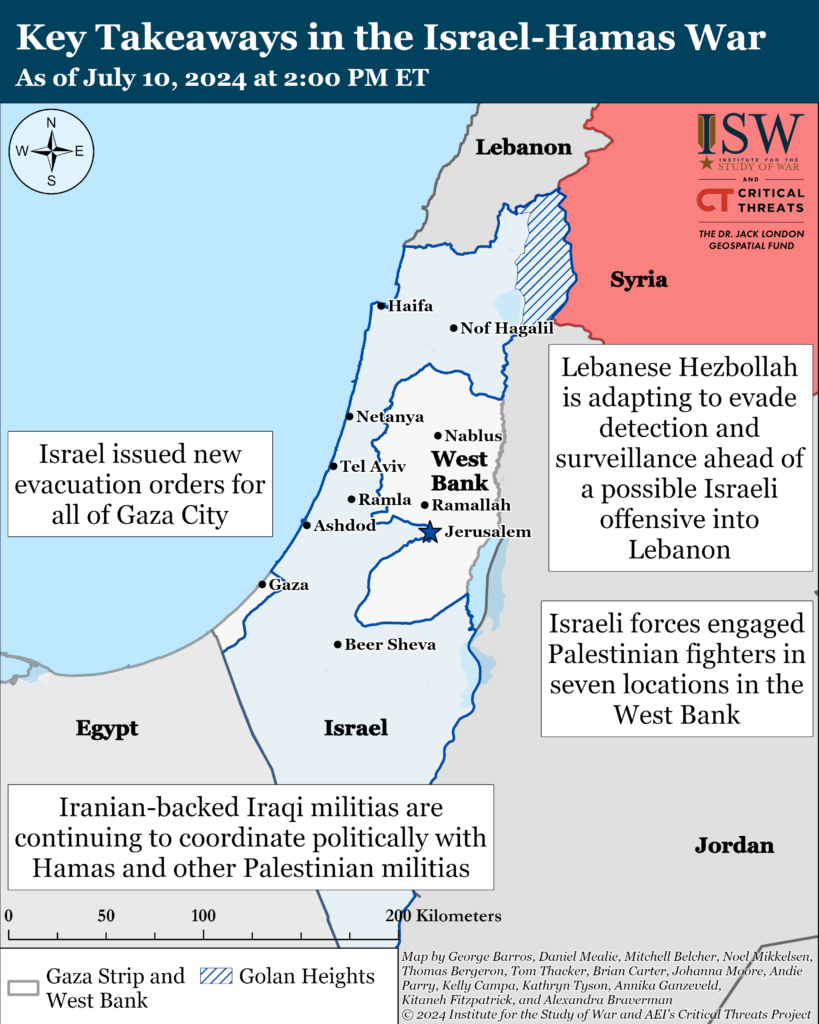
Gaza Strip
Axis of Resistance objectives:
Erode the will of the Israeli political establishment and public to sustain clearing operations in the Gaza Strip
Reestablish Hamas as the governing authority in the Gaza Strip
The IDF 98th Division completed clearing operations in Shujaiya on July 10. The IDF stated on July 10 that it has killed dozens of Palestinian fighters and destroyed eight militia tunnels in Shujaiya since beginning clearing operations there on June 27.[xvii] The IDF reported on July 9 that two of the tunnels it destroyed extended to the Israeli border near Nahal Oz.[xviii] The IDF added that it uncovered indicators that Palestinian fighters have attempted to reestablish command-and-control in Shujaiya.[xix] The IDF said that it found “equipment that allows for a long stay,“ including electricity and gas infrastructure.[xx] Palestinian Islamic Jihad (PIJ) fired mortars and small arms targeting Israeli forces in Shujaiya on July 10.[xxi]
The IDF 99th Division continued clearing operations in Gaza City on July 10. The IDF stated that it deployed two additional units to Gaza City to conduct operations around a UNRWA headquarters.[xxii] The IDF raided the building and killed and detained several Palestinian fighters on July 10.[xxiii] The IDF stated that Hamas and PIJ used the headquarters to detain individuals, house fighters, and store weapons.[xxiv] Seven Palestinian militias conducted improvised explosive device (IED), indirect fire, and small arms attacks targeting Israeli forces west and southwest of Gaza City on July 10.[xxv]
The IDF Air Force conducted airstrikes killing several Hamas fighters in the central Gaza Strip on July 10.[xxvi] The IDF stated that the strikes targeted fighters who were responsible for building tunnels and conducting anti-tank attacks in the area.
An IDF airstrike killed a Hamas fighter who participated in the October 7, 2023, attack into Israel in Khan Younis on July 9.[xxvii] Palestinian medical officials claimed that the airstrike killed at least 29 civilians near a school in Abassan, east of Khan Younis.[xxviii] The IDF is reviewing reports that the strike killed civilians.[xxix]
The IDF 162nd Division continued clearing operations in Rafah on July 10. The IDF killed several Palestinian fighters, located weapons, and destroyed underground infrastructure in the area.[xxx] The al Aqsa Martyrs’ Brigades mortared Israeli forces.[xxxi]
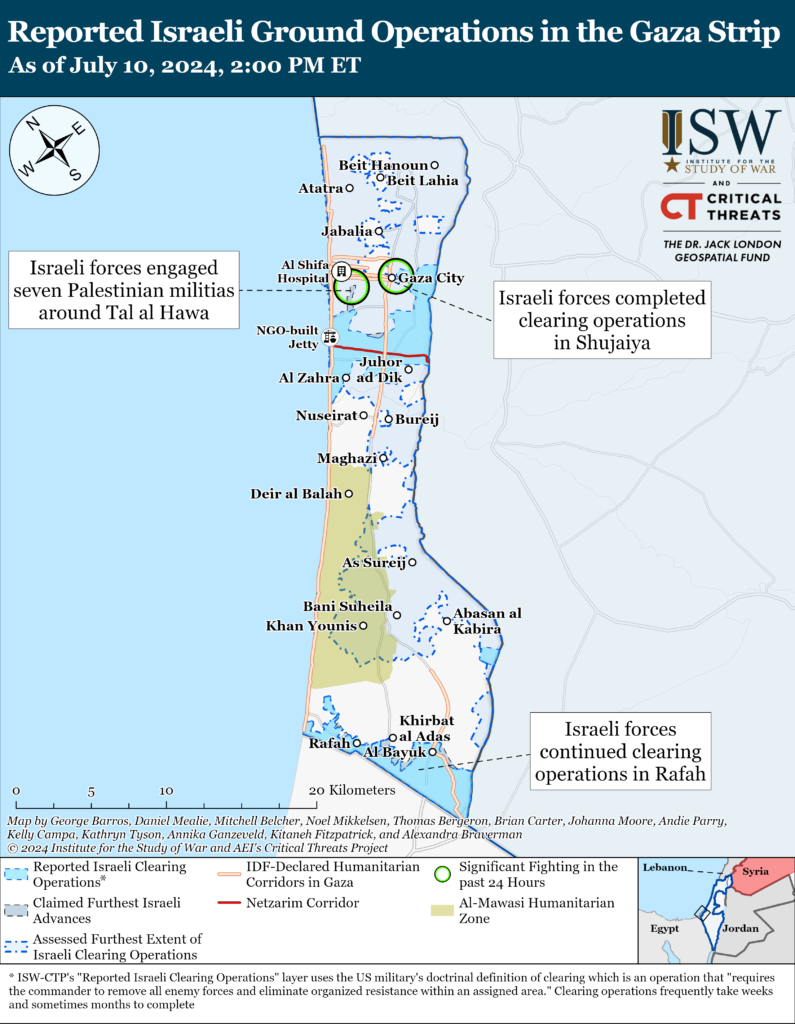
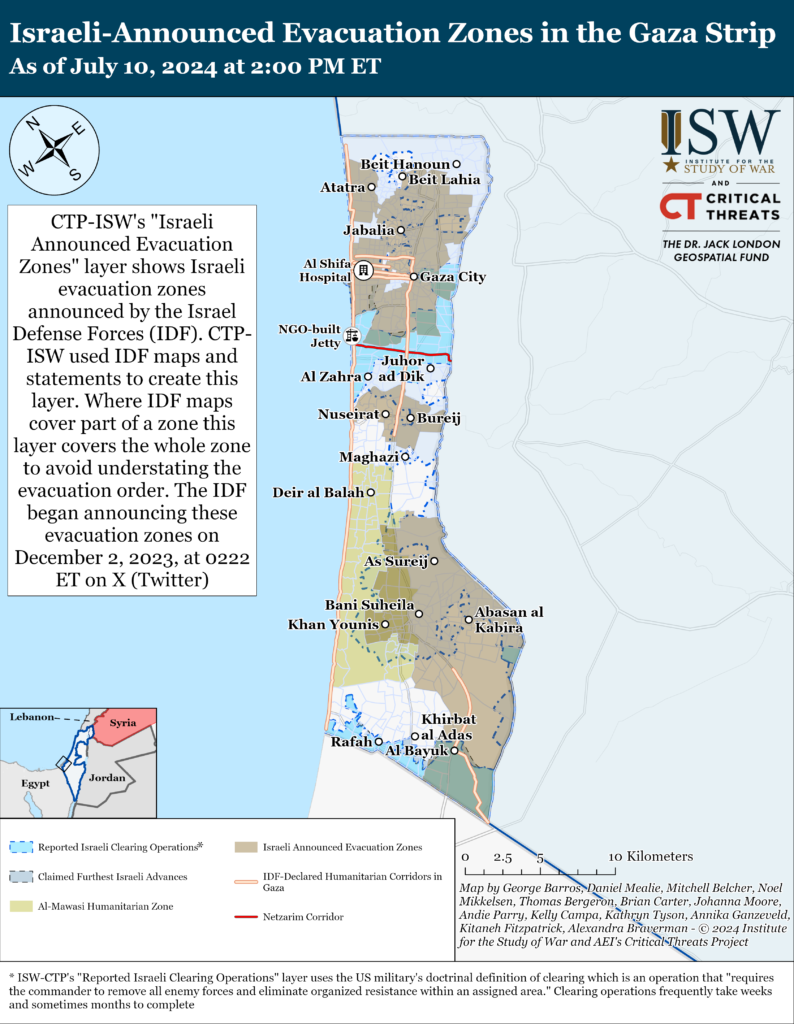
White House Middle East envoy Brett McGurk met separately with Israeli Prime Minister Benjamin Netanyahu and Defense Minister Yoav Gallat on July 9 and 10, respectively, to discuss the ongoing ceasefire talks with Hamas.[xxxii] Netanyahu said in his meeting with McGurk that he is committed to reaching a ceasefire and hostage deal if “Israel’s red lines are maintained.” Netanyahu said on July 7 that he would only agree to a deal that would allow Israel to continue the war until Israel has destroyed all of Hamas’ military and governing capabilities.[xxxiii] Gallant stressed during his meeting with McGurk the importance of seizing the opportunity to achieve an agreement for the return of Hamas-held hostages.[xxxiv] Gallant added that Israel could withdraw troops from the Philadelphi Corridor if a solution is found to prevent Hamas arms smuggling across the Egypt-Gaza Strip border.[xxxv] Israel and Egypt are continuing to discuss the installation of sensors along the Philadelphi Corridor to prevent Hamas arms smuggling.[xxxvi]
US Central Intelligence Agency (CIA) Director Bill Burns is meeting with senior Qatari, Israeli, and Egyptian officials in Doha to discuss the ceasefire deal.[xxxvii] Unspecified sources told Axios that the meetings are meant to close the remaining gaps between Hamas and Israel on the deal.[xxxviii] Burns also reportedly met with Qatari Prime Minister Mohammad al Thani on July 9, presumably to discuss the deal.[xxxix]
The United State plans to dismantle its military pier off the Gazan coast in the coming days.[xl] US Department of Defense spokesperson Major General Pat Ryder said on July 9 that the United States “tentatively” plans to reattach the pier to the Gaza Strip ”sometime this week,“ which would enable the delivery of remaining humanitarian aid to the strip. Unspecified US officials said that the United States will deliver the remaining aid on July 10 and then dismantle the pier.[xli]
West Bank
Axis of Resistance objectives:
Establish the West Bank as a viable front against Israel
Israeli forces seized 150 sacks of “explosive materials” in five locations across the West Bank on July 10.[xlii] The IDF reported that Palestinian fighters used the explosive materials to manufacture improvised explosive devices (IED). The IDF detained six individuals who sold the explosive materials. Palestinian militia-affiliated media reported that the seized materials were agricultural fertilizers.[xliii] Most fertilizers contain calcium ammonium nitrate, which can be used to produce ”makeshift bombs.”[xliv] A 2015 US Army report stated 74 percent of homemade explosives employed against coalition forces in Afghanistan were produced using ammonium nitrate extracted from fertilizers.[xlv] The IDF confiscation of explosive materials follows a 15-hour long raid in Nour Shams refugee camp on July 9, during which Israeli forces destroyed “dozens” of IEDs and one vehicle rigged with explosives.[xlvi]
Israeli forces have engaged Palestinian fighters in at least seven locations in the West Bank since CTP-ISW’s last data cutoff on July 9.[xlvii] The al Aqsa Martyrs’ Brigades and PIJ fired small arms and detonated IEDs targeting Israeli forces in Tulkarm and Nablus.[xlviii] Palestinian fighters targeted an IDF outpost in Mount Gerizim, Nablus, with small arms.[xlix] The IDF separately detained six wanted persons across the West Bank on July 10.[l]
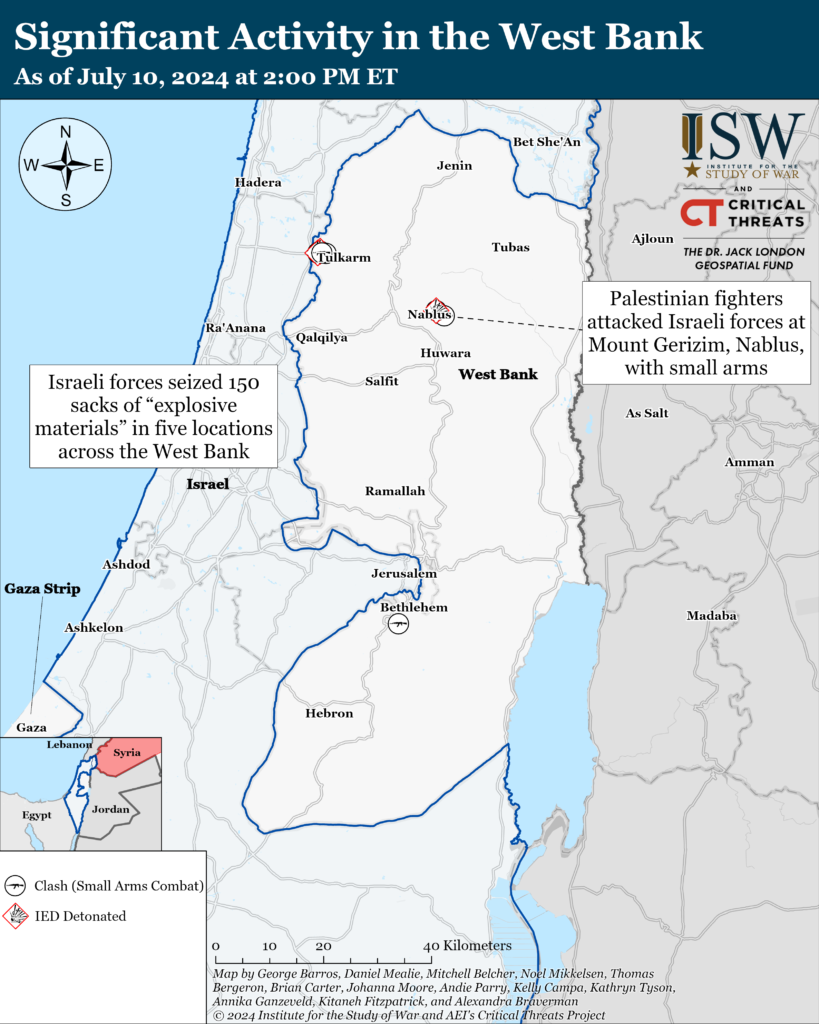
Southern Lebanon and Golan Heights
Axis of Resistance objectives:
Deter Israel from conducting a ground operation into Lebanon
Prepare for an expanded and protracted conflict with Israel in the near term
Expel the United States from Syria
Iranian-backed militias, including Lebanese Hezbollah, have conducted at least three attacks into northern Israel since CTP-ISW’s last data cutoff on July 9.[li] The IDF said that it detected approximately 30 rockets launched from Lebanon targeting the Galilee panhandle on July 10.[lii] Lebanese Hezbollah has not claimed the attack at the time of this writing.
The IDF Air Force struck Lebanese Hezbollah infrastructure in Qabrikha, southern Lebanon, after Hezbollah rockets killed two Israeli civilians in the Golan Heights on July 9.[liii] The IDF said that the rocket fire originated from Qabrikha.[liv]
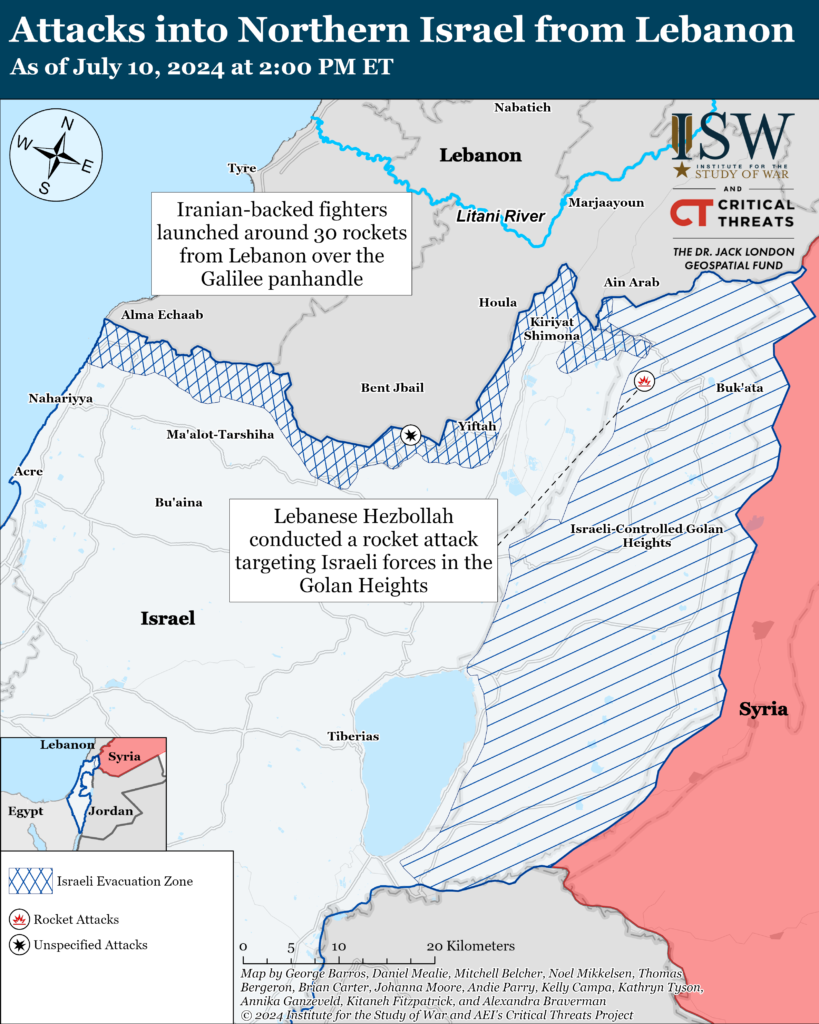
Iran and Axis of Resistance
The IDF fired artillery and tank fire targeting a Syrian Arab Army (SAA) site in southern Syria on July 10.[lv] The IDF said that it conducted the attack in response to the SAA violating the 1974 Agreement on Disengagement between Israel and Syria. Syrian media reported that the IDF dropped leaflets following the attack warning the SAA against operating within the buffer zone between the Golan Heights and Quneitra, Syria.[lvi] The IDF has previously shelled SAA outposts in response to SAA operations in the buffer zone.[lvii] The IDF rarely acknowledges its operations in Syria, so it is notable that the IDF commented on this incident.
The Islamic Revolutionary Guards Corps (IRGC) Ground Forces engaged likely anti-regime Kurdish militants who tried to enter West Azerbaijan Province in northwestern Iran on July 9.[lviii] It is unclear whether the militants came from Iraq or Turkey. Iran and Iraq signed a security agreement in March 2023 that requires Iraqi authorities to disarm and relocate members of Kurdish opposition groups away from the Iran-Iraq border.[lix] IRGC Commander Major General Hossein Salami and Iraqi Kurdistan Regional Government President Nechirvan Barzani discussed border security along the Iran-Iraqi Kurdistan Region border in early May 2024.[lx]
Iranian President-elect Masoud Pezeshkian reiterated his support for the Axis of Resistance on July 10. Pezeshkian discussed strengthening bilateral relations between Iran and Syria as well as with the Axis of Resistance broadly in a phone call with Syrian President Bashar al Assad.[lxi] Pezeshkian separately underlined his support for Hamas in a message to Hamas Political Bureau Chairman Ismail Haniyeh, stating that Iran has ”its human and Islamic duty“ to support Palestinian militias.[lxii] Pezeshkian previously wrote a letter to Lebanese Hezbollah Secretary General Hassan Nasrallah on July 8 in which he similarly emphasized his support for Hezbollah attacks into Israel.
Pezeshkian also discussed the “fraternal nature of [Iranian-Venezuelan] relations” and Iran and Venezuela’s shared stance on the Israel-Hamas War in a phone call with Venezuelan President Nicolas Maduro.[lxiii] Iranian officials have previously characterized Venezuela as an extended member of the Axis of Resistance.[lxiv]
The Islamic Resistance in Iraq—a coalition of Iranian-backed Iraqi militias—claimed that it conducted a drone attack targeting the Port of Ashdod on July 9.[lxv] Israeli officials and media have not commented on the claimed attack at the time of this writing.
The Houthis claimed three drone and missile attacks targeting merchant vessels in the Arabian Sea and Gulf of Aden on July 9.[lxvi] The Houthis claimed a drone and ballistic missile attack targeting the United States-flagged MAERSK SENTOSA in the Arabian Sea.[lxvii] The Houthis also claimed two drone attacks targeting the Israeli-flagged MSC Patnaree in the Gulf of Aden and the Maltese-flagged Metropolis in the Arabian Sea.[lxviii]
US Central Command (CENTCOM) destroyed a Houthi drone in Yemen on July 9.[lxix] CENTCOM determined that the drone presented an imminent threat to US, coalition, and merchant vessels in the region.
United Kingdom Maritime Trade Operations (UKMTO) reported that an explosion occurred near a vessel approximately 40 nautical miles south of al Mukha, Yemen, on July 10.[lxx] The explosion did not cause any injuries or damage to the vessel, which continued to its next port of call.
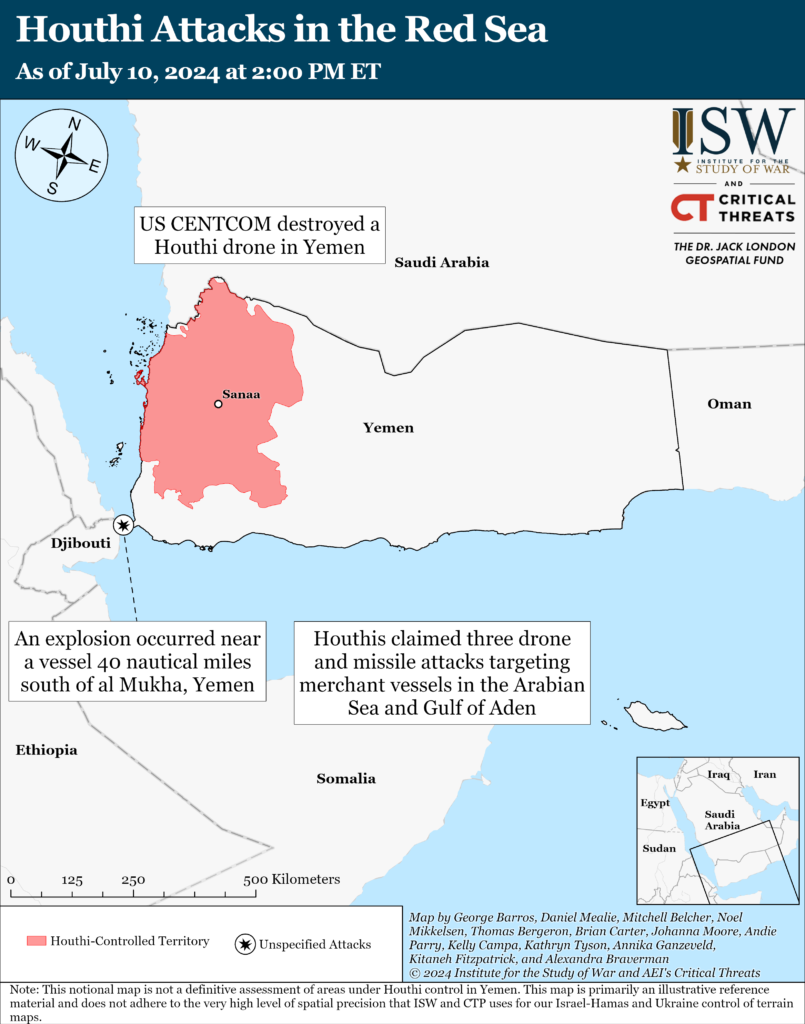
 Eurasia Press & News
Eurasia Press & News
